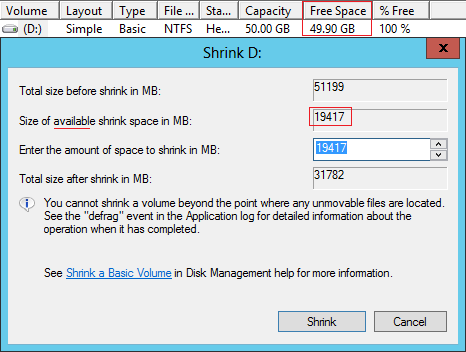Disk partitions have been allocated after installing Operating System, but sometimes you need to repartition hard drives. For example: you forgot to edit disk while installing Windows, so the system partition C occupied all disk space. Another typical example is that drive D runs out of space but there is plenty of free space in C drive. In these situations, you can shrink system partition C to create new volume or expand other partitions without starting over. To shrink C: drive on Windows Server 2012 R2, there are two choices: inbuilt Disk Management and 3rd party disk partition software. This article introduces detailed steps with both tools.

Shrink system partition without software
Windows Server 2012 has Shrink Volume feature in the built-in Disk Management utility, which is able to shrink system partition and any data volumes without losing data. It is easy, fast and able to decrease partition without rebooting server, but meanwhile, it has some restrictions.
How to shrink C drive in Server 2012 R2 via Disk Management:
- Press Windows and X on your keyboard, and then click Disk Management from the list.
- Right click C drive and select "Shrink Volume".
- Enter the amount of space and click "Shrink" to proceed.
In a short time, the system C drive will be shrunk.
If you just want to shrink system partition to create new volumes, you can achieve without any software in most cases. But Disk Management is not the best tool because of some limitations.
Limitation to decrease C drive with Disk Management
1. Cannot shrink C drive beyond unmovable files
In the shrinking window, there is a tip - You cannot shrink a volume beyond the point where any unmovable files are located.
In my test server, D drive is blank with 50GB space, but in the shrinking window, Disk Management gives me only 19417MB (18.96GB) available space.
The "unmovable" files include Paging file, Hibernation and other large files. Most of such files are located in system C drive by default. Therefore, you may encounter such issue while shrinking C: drive.

2. Cannot extend other volume after shrinking partition C
As you see in my server, Extend Volume is disabled for D: drive after shrinking both C: and E, this is because:
- Unallocated space can only be made on the right after shrinking a drive with Disk Management.
- Unallocated space can only be combined to the left contiguous drive with Extend Volume function.
Therefore, no matter you want to extend D: drive or the System Reserved partition, you cannot achieve by shrinking partition C via Disk Management.
Another native tool - Diskpart command has same restrictions.
How to shrink C drive and expand volume D
To shrink volume C in Windows Server 2012 R2, NIUBI Partition Editor is better choice, because it has more advantages.
- You just need to drag and drop on the disk map to resize partition.
- Both NTFS and FAT32 partitions can be shrunk and extended.
- It is able to move these unmovable files and shrink partition to much smaller.
- Unallocated space can be made on either left or right while shrinking partition.
- Unallocated space can be combined to either contiguous or any nonadjacent partitions on the same disk.
Download NIUBI Partition Editor and follow the steps in the video:



